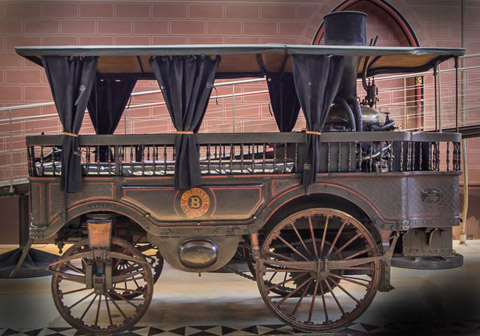 As for Italy, it is necessary to mention a very successful eight-seat design, light steam vehicle of the Italian builder Virgilia Bordino, officer, an engineer of the Italian army in Sardinia. Three such vehicles, to some extent modeled on English constructions, were built in an arsenal in Turin. However, their further fate is unknown.
As for Italy, it is necessary to mention a very successful eight-seat design, light steam vehicle of the Italian builder Virgilia Bordino, officer, an engineer of the Italian army in Sardinia. Three such vehicles, to some extent modeled on English constructions, were built in an arsenal in Turin. However, their further fate is unknown.
Until the collapse of motorism in England as a result of the adoption of the Red Flag Act” France could not boast (picture Cugnotem) any significant achievements in the field of motor vehicle construction. However, after that time, it definitely took over the baton of priority. This was done by an extremely talented constructor, a bell caster by profession, Amedee Bollee, without feeling, that his and his family's name will be permanently recorded in the history of world motoring.
After a few years dedicated to the construction of highly successful steam cars, Bollee left in a year 1873 on the public road with its newest steam omnibus, called "Obeissante” ("Obedient”). The vehicle had two steam engines, driving each of the rear wheels separately, and the wheels were already rubberized, vulcanized according to the Thomson patent.
In addition to the water tube boiler, supplying steam 20 horses of the steam engine, Bollee used many new inventions, m. in. point steering system, driving the front wheels of the vehicle in curves exactly along Curves with the correct radii. Because the omnibus was quite fast, had to be well sprung, to neutralize bumpy, and especially the rocky roads of the then France. The constructor used soft leaf springs, as we see and in today's cars. Also new was the power transmission via a chain gear with the use of a gearbox.
Bollee made several longer journeys with this vehicle, of which the journey from Le Mans to Paris has gone down in history. Vehicle weighing up to 4800 kilograms has reached (on massive tires) average speed 42 km/h, which no modern bus would be ashamed of, and which at that time was so extraordinary, that she had immortalized Bollee, as the first victim of the age-old antagonism between drivers and the police. Bollee received on these journeys as many as 75 criminal warrants for developing excessive speed (thus contributing to the invention of the institution of penal fines), for even the mounted policemen could not catch up with the "traffic lightning"” and they only got her on the narrow streets of the town during forced stops necessary to replenish the water supply. (The time of these stops was, by the way, included in the total travel time, which is the basis for calculating the average speed).